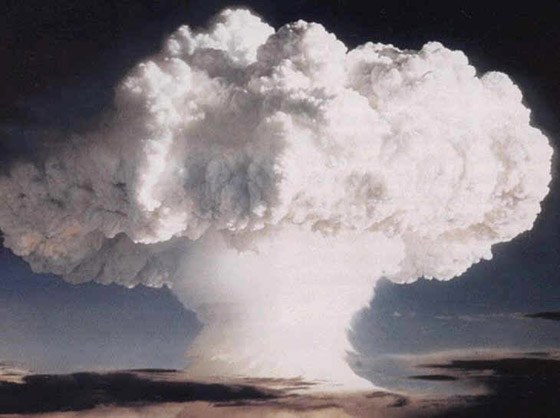The explosion of a nuclear bomb, depending on the nominal power, causing catastrophic destruction in the radius from one to ten kilometers from the place of initiation. In the midst of a raging blast of energy monstrous: temperature rises to several hundred thousand degrees and the pressure abruptly increases from five to eight times, then suddenly drops below atmospheric. To survive in the midst of a nuclear explosion impossible, even in a fortified shelter: a surge in seismic activity resulting in the immediate collapse of any cavities, located closer than two kilometers from the surface of the earth.
In the area of secondary lesions to survive is possible. At a distance of more than ten kilometers from the explosion temperature rise is negligible, but there are other affecting factors that change over time. When triggered, the warning of nuclear attack should be to find shelter. Ideally, they will be the metro or a specialized bomb shelter. To less reliable shelters are basements and concrete reinforcements, located below ground level. At the moment of explosion in the sky there is a bright flash, which the human eye is still able to see. In just a few seconds the brightness of the light increases to light radiation of tremendous power.
If no suitable fortifications around there, should as soon as possible to hide behind the projection of opaque material with high density. Well go concrete barriers, large rocks, walls of buildings. If nothing of the kind, should in any way be at least 1-1,5 meters below ground level. Intense light emission lasts 30 to 80 seconds by heating objects up to several hundred degrees, so the presence of the person in open space within a radius of 30 kilometers from the explosion deadly. The influence of light radiation is causing widespread fires and melting, partly destroying the building.
Incident 40 seconds after initiation, there is a strict ionizing radiation, able to cause death. The effect radiation have on stage the residual glow of a nuclear bomb. Stone walls, concrete slab, and the thickness of the soil can protect from the action of ionizing radiation, but must wait until the active phase of the explosion.
One minute after the initiation of a nuclear warhead supersonic shock wave beyond the epicenter, and loses speed as it spread. A reliable shelter from the shock wave remain deep cellars and wells, in their absence, you can hide in the folds of the terrain. In open terrain wave can lift into the air up to two meters of the soil.
After the explosion, it was necessary to leave the affected area. After 6-10 hours is the primary falling on the surface of suspended particles decay products. You should to go against the wind in the case, if it is directed to the epicenter of the explosion or one of the parties. If the wind is blowing from the epicenter, you should exit the affected area perpendicular to the direction of air flow.
In the area of secondary lesions to survive is possible. At a distance of more than ten kilometers from the explosion temperature rise is negligible, but there are other affecting factors that change over time. When triggered, the warning of nuclear attack should be to find shelter. Ideally, they will be the metro or a specialized bomb shelter. To less reliable shelters are basements and concrete reinforcements, located below ground level. At the moment of explosion in the sky there is a bright flash, which the human eye is still able to see. In just a few seconds the brightness of the light increases to light radiation of tremendous power.
Light emission
If no suitable fortifications around there, should as soon as possible to hide behind the projection of opaque material with high density. Well go concrete barriers, large rocks, walls of buildings. If nothing of the kind, should in any way be at least 1-1,5 meters below ground level. Intense light emission lasts 30 to 80 seconds by heating objects up to several hundred degrees, so the presence of the person in open space within a radius of 30 kilometers from the explosion deadly. The influence of light radiation is causing widespread fires and melting, partly destroying the building.
Penetrating radiation
Incident 40 seconds after initiation, there is a strict ionizing radiation, able to cause death. The effect radiation have on stage the residual glow of a nuclear bomb. Stone walls, concrete slab, and the thickness of the soil can protect from the action of ionizing radiation, but must wait until the active phase of the explosion.
The shock wave
One minute after the initiation of a nuclear warhead supersonic shock wave beyond the epicenter, and loses speed as it spread. A reliable shelter from the shock wave remain deep cellars and wells, in their absence, you can hide in the folds of the terrain. In open terrain wave can lift into the air up to two meters of the soil.
Radiation pollution
After the explosion, it was necessary to leave the affected area. After 6-10 hours is the primary falling on the surface of suspended particles decay products. You should to go against the wind in the case, if it is directed to the epicenter of the explosion or one of the parties. If the wind is blowing from the epicenter, you should exit the affected area perpendicular to the direction of air flow.
